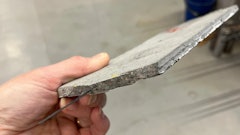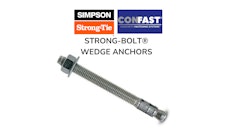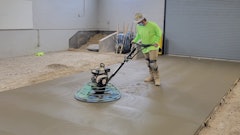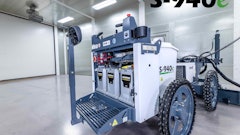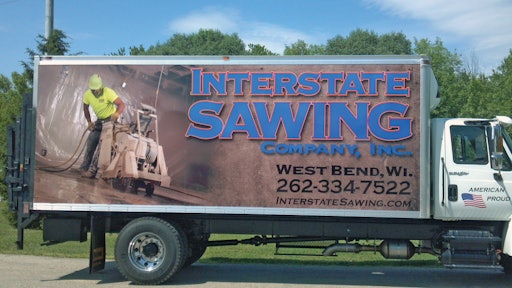
In an era when most construction business owners face shrinking margins, increased competition and fewer jobs, Interstate Sawing, West Bend, Wis., is on an upward trend. Its fastest growing segment is confined space demolition and excavation, supported with a seven-model line-up of remote-controlled demolition robots and electric excavators. Crews use the equipment to perform concrete demolition and removal in hard-to-reach places eight to 12 times faster than traditional methods.
Owner Duke Long bought his first robot five years ago. By 2011, 15 percent of his annual sales were in this market. In 2012, it was 25 percent of his sales. Long says this equipment allows his company to perform work its competitors can’t do, so much so, in fact, he has found himself working as a sub for some of those competitors performing their removal because his equipment allows him to do it faster.
This positive change in Long’s company was fueled by his understanding of the importance of equipment. Long describes himself as a true owner-operator, spending the majority of his workdays in the field rather than back at the office. “Any tradesman will tell you, you’ve got to have the right tools,” Long says. He strives to ensure his employees have the right tools in the field, and it has paid off.
Owner-operator
Long started his career in concrete sawing and drilling running out-of-town jobs for a cutter for 10 years. Long dreamed about owning his own business, but was terrified of losing what he considered “the best job I ever had.” In 1996, he quit fantasizing — he sold everything he owned, prepaid his mortgage and family’s health insurance for two years, and took the remaining cash to start Interstate Sawing with one pickup truck and two saws. By the end of his first year he pulled in more than $1 million in revenue on road sawing projects alone. He kept making money, and kept pumping money back into the business. The business grew, and within two years he had 12 trucks, 10 employees, a secretary and sales people, and he bought the building he was renting.
Early on, Long realized road sawing projects alone wouldn’t allow for the level of company expansion he wanted. “I identified this kind of work as a lowball market that was saturated and offered low margins. As a business owner, I knew I had to move away from it to succeed,” he explains.
Long diversified. He added a full range of concrete cutting services while maintaining a strong percentage of work in the road sawing arena. These new services increased his potential client list 10-fold. “We do things other concrete cutters don’t do. It’s all about diversity within your industry,” he says.
Today, Long’s business is set up with 17 production trucks. Interstate Sawing’s operators have Class A CDLs so they can drive 33,000-pound trucks with trailers over 10,000 pounds and avoid overloading a smaller truck, a safety issue Long saw important for his operators and anyone who shares the road with them. Each truck has a 4,000-pound lift gate and is stocked with all the equipment an operator could need for a concrete cutting or drilling project — concrete chain saws, pavement saws, wire saws, wall saws, core drilling units and more. The wide range of equipment gives his operators the ability to choose the best tool for the job when they arrive at the jobsite. “We only see about 20 percent of our jobs before we agree to take them,” Long says. “With our trucks stocked with all this equipment, I know our guys are ready for anything.”
Not only does Long give his employees the tools they need to tackle just about any project, he gives them back-up equipment to ensure the job will get done even if the first piece of equipment breaks down. “Since day one, I doubled up on equipment. It doubles overhead, but I have never had to pull off a job,” he says.
Robots on the job
Interstate Sawing’s addition of the robots and the entrance into the confined space demolition and excavation market was a positive change for the company. Interstate Sawing’s client list is growing and the equipment is even helping Long diversify the types of jobs his company gets. Interstate Sawing typically completes 20 to 25 small jobs a day, with some employees handling up to three jobs a day. The robots help Interstate Sawing land jobs they stay on up to four months at a time. “That kind of work is good for your bottom line. You get settled in on a job and your margins start going up.” About 10 percent of Interstate Sawing’s work is a month or longer.
A recent job demolition and removal project is a good example of how Interstate Sawing’s diversification helped them get a job and impress a customer. Another concrete cutter from the area was originally hired to take out several hundred feet of drain trench at the Kikkoman Foods manufacturing facility in Walworth, Wis., where the company manufacturers and packages its soy sauces and other food products. The job required the contractor to use all electric equipment because it was a food service job. “The concrete cutter who originally got the job expected the concrete to be 6 to 8 inches thick. It was actually 36 inches thick,” Long says. “They told the customer that Interstate Sawing was the only company that could get this done, and they subcontracted us to do the work.”
Interstate Sawing cut 2 feet deep electrically. Then they used million-ton splitters and robots to break out and pick-up the concrete and load it into dumpsters for removal. Finally, Interstate Sawing crew members used the company’s electric equipment to excavate up to 6 feet deep in clay.
“We completed the job within the timeframe needed to remove 6- to 8-inch-thick concrete. We kept our customer happy, which meant they were able to keep their most important customer happy. The moral of the story is that if traditional methods were used, this job would have never been completed on time. It is our specialty equipment, such as the robots, mini-excavators and hydraulic splitters, that help us get the job done efficiently every time.”























